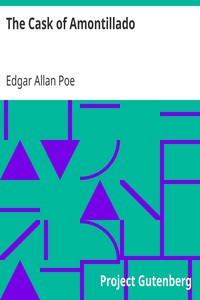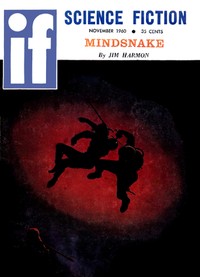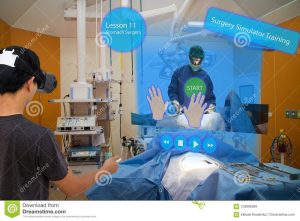Author: Rich Te
Yes! The Amontillado!

https://www.gutenberg.org/files/1063/1063-h/1063-h.htm
The cask of Amontillado – Edgar Allen Poe
The cask of Amontillado is a highschool favorite of mine. Easily one of the most memorable stories I know. I remember in my youth thinking how terrifying it must have been for poor Fortunato, how ironically unfortunate. There are comedy elements throughout the story, but it’s hard to fathom the mindset of a psychopath with the determination to kill. This story is about a Montresor man who is great friends with a man of Fortunato, he seeks revenge for an unknown reason and buries him alive in his family’s catacombs.

https://www.gutenberg.org/files/60935/60935-h/60935-h.htm
Don’t think about it – William W. Stewart
This story is messed up. It leaves food for thought that it could be about a real monster that a toddler has difficulty conveying information to his parents about, or it could be about how the child, Tommy, set his aunt and his house on fire because of anxiety. Either way, the story is about a three-year-old named Tommy who can see a mousehole in his closet. He has trouble communicating with the grown-ups and he understands that their perspective is closed off from his reality. So the mousehole contains a monster that’s bloodthirsty and the kid just wants to take matters into his own hands. In the end, it’s a happy story because he gets a new house and a baby sister.
The Future of the Book mini-essay
Books today can still come in traditional formats but at the expense of the dwindling publications that exist. Post-modern publications are phasing out. Some artists still make print, and with the push towards eco-friendly alternatives, digital publications are here to stay. Like how Jessica Pressman writes in “The Aesthetic of Bookishness in Twenty-First Century Literature” she states a great understanding, “The book will not become obsolete with new reading platforms, but rather, will change and develop new incarnations and readerships.” The idea isn’t to eradicate print but to make new knowledge accessible. In the past thirty years, we as a society have digitized 70% of modern publications, and all new publications are made purely for e-readers or made available on the web. Libraries haven’t changed much since 2020, however, the buildings are now full of computers. Libraries still carry prints that haven’t been digitized and analog content is still cherished, but with all new publications being digital, libraries resemble offices stacked upon one another. Digital e-readers are more popularly rented out and content is downloaded from the library itself. AR rooms in libraries are provided for presentations as commonly as they are in the office and classrooms.
Libraries of the Future
 Photo by Marcus Loke on Unsplash
Photo by Marcus Loke on Unsplash
Books still exist, but with a focus on accessibility, we begin to deepen our understanding of books with an immersive relationship. In Amaranth Borsuk’s “The Book,” she talks about Socrates’ fears of sharing ideology through literature when she writes “Their concerns echo contemporary anxieties about the ways digitally mediated reading and writing shortens our attention spans and ability to engage deeply with texts.” This isn’t the case or reality today. As we’ve adapted to technology, we’ve developed new tools and reinvented the pen. Now more than ever creativity can be delivered through multimedia and we can share ideas that are cohesive. Ideas aren’t just text, ideas aren’t just language, and communication isn’t just words. We’re incorporating all the senses, touch, sound, sight, taste, and smell. Although 4D content using taste and smell is only an artist’s form of entertainment today and not necessarily practical outside of a kitchen or lab. The fact still remains that we can share information that reaches our audiences and our content only proliferates the process of thought and understanding allowing us to connect the dots between ideas that we couldn’t before with purely print publication.
Ekkasit919 | Dreamstime.com
In academia and among the consumers we’re seeing multiple forms of digestible content. Privatized entertainment has jumped on board in creating content for multimedia-based entertainment. 3D TVs seem like a precursor to today’s development in media. In classrooms, we’re seeing AR projectors that help professors convey ideas in ways they couldn’t before. Hulu and Netflix regularly showcase 3D movies with that same technology. All platforms have jumped on the idea of digitized multi-media texts. For example, cookbooks are readily available on Amazon prime with video and text. Netflix has gone beyond their “choose your own adventure” films and succumbed to the idea of providing literature. We’re at a period where we once thought that video would overtake creative media and yet it’s the exact opposite. Immersive content is thriving. In Borsuk’s “The Book” talking about when digital texts were first introduced, the author says “The very existence of such digital books, however, precisely because they allow content to be poured into any crystal goblet available, gave rise in the 1990s and 2000s to e-readers” given the time, accessibility and convenience seemed like a prototype back then. In comparison, what we have today is that of a cauldron or a buffet table of content and it is us who now have the option to dip our crystal goblets into wherever we wish. As long as you have a tablet, an AR headset, a personal computer, or a projector all media is accessible across all platforms.
| Dreamstime.com
Not all books are yet to be converted to AR formats, but when the readily available digital publications are cheaper and massively distributed from student to student. The negative aspects of our situation are simplified to the demand for content and media conversion rising as we enter a new era of publication. Just as students would beg for PDFs and ebooks to prevent carrying 50-pound backpacks from class to class back in the 20s, students demand content readily available on their devices and it needs to be available yesterday, today, and tomorrow. Digital publication distribution is booming, but we owe the concept to Angela Ruiz Robles, as referenced in Borsuk’s examination of the book:
One of the earliest was that of Galician schoolteacher Ángela Ruiz Robles, who patented a mechanical book in 1949 that would use electricity and compressed air to create an illuminated interactive page. While the project was never realized, Robles continued to develop the idea, patenting and prototyping her Enciclopedia Mecánica (Mechanical Encyclopedia), its successor, in 1962 to condense the number of textbooks young students would have to carry.
While technology has advanced and while we have simultaneously adapted, it’s starting to feel like the narrative doesn’t change. It’s the same conversation we’re having with technology in identifying how the codex has evolved and what it will become. While innovation apparently happens, it feels like nothing has changed. We’ve had this conversation before with personal computers, we’ve had this conversation with mobile devices, and we’re having it now. Reflection is important especially if we think about how digital publication started. In the early days creating a website and making a personal blog wasn’t considered authoritative. As children, we would play around with the abilities of starry backgrounds and different headers, but we didn’t consider what we have now: Full-blown digitized publications, chapters, illustrations, multi-media, everything you want in a book, but with just a little bit more. We’re able to take authoritative concepts and instructional information and visualize physical labs in new ways in the classroom. Blackboards are now drag-and-drop three-dimensional spaces. With how easy and developed programming has become over three decades I could have never foreseen it being a regular skill.
We’re at the forefront of the next step in advancement, where we have a few AR settings available to the consumers and specifically the disabled. Folks who don’t have the option to leave their homes or can’t afford to be mobile are presented with the alternative of virtual classrooms much more advanced than the days of Zoom. With learning environments kept in mind, educational software is designed in the same way we used to design video games. Physics engines, user interface, avatars, accessibility, and communications are developed to put the student in the classroom. This allows campuses to reach students across the world. This gives homeschooled children the option to have that hybrid social environment. With digital content in full swing, you could say that it’s all backward compatible. With AR projectors, there’s no need for a computer, but if you have a computer, there’s no need for a tablet, and if you have a tablet there’s no need for a book, and if you have a book there’s no need for papyrus. But given the option, we can replicate any medium with what we have today. Featured in Borsuk’s book a rudimentary concept was introduced in 2011 “The Icebook” by Davy and Kristen McGuire, “Described by its creators as ‘a miniature theater show made of paper and light,’ the book use projection mapping to play a fairy tale across a series of eleven blank pop-up pages. The projected video adds characters, detail, and lighting effects to a wooded landscape, a Victorian mansion, a lighthouse, a church, and other settings.” If we can imagine a pop-up book for fictional stories 40 years ago. Imagine what we can do today with non-fiction content minus the cameras and well beyond the graphics processing of video games 20 years ago.
Still, the fact is we are making another breakthrough in creating immersive learning environments and taking the whole experience of making data portable. While we keep our publishers in mind, we know we have production studios dishing out content after content, we have to start thinking about the future of media, texts, and communication. Not much has changed in the past 30 years, digital content may have been elementary and in its early stages compared to how integrated it has become today. However, the facts are even the company Meta has had this concept advertised for years until it has become fully realized, webpages were just online newspapers. We could sit here and compare modern ideas with the way author and artist, Ulises Carrion, discussed classical publication and the craft that comes with creating books of his time and how we perceive content and format, but he was right when he was quoted in Borsuk’s “The Book,” Carrion, at a speech almost 70 years ago saying:
“I firmly believe that every book that now exists will eventually disappear.” And true to form, he expresses little sadness over the loss: “And I see here no reason for lamentation. Like any other living organism, books will grow, multiply, change color, and, eventually, die. At the moment, bookworks represent the final phase of this irrevocable process. Libraries, museums, archives are the perfect cemeteries for books.”
Today, we need to consider and relish how expansive the information superhighway has evolved and how we’ve put literally all of data within databases archiving itself a thousand times over and how we put comprehensive information into our fingertips allowing us to visualize, collaborate, and share ideas. Tomorrow we need to be expecting more in terms of accessibility, usability, portability, and affordability to streamline this process more than ever. We have the content, but how do we reinvent the book?
work cited:
Borsuk, Amaranth. The Book. The MIT Press, 2018.
the e-pen is not mightier than the sword
While modern publishing provides the convenience of revision and delivers ideas to the masses at an instance, growing up alongside the internet and technology hasn’t always been as convenient as this essay says to be. Yes, we do have scholarly journals at our fingertips and information is as accessible as asking for it, however, when it comes to publication for students, we still have the shuffle of finding textbooks for the right price every semester. Paperback and hardback novels are still thriving in the modern day. It comes at a premium to get print and resources.
With CGI improving and hardware development accelerating year by year, digital storytelling and modern media become a fairytale turn to life. Technology has grown exponentially faster than we as a society could have foreseen. It’s important to take an introspective look for we as developers have become so adaptable and keep finding ways to ingrain uses for pocket-sized supercomputers. But still, when it comes to organization and record keeping, what remains constant is ink and paper. In terms of digital organization, it’s an extra step to maintain digital formats, this is just another example of “if it ain’t broke, don’t fix it.”
“A sequence of spaces”
“A book is not a case of words, nor a bag of words, nor a bearer of words.” – Ulises Carrion (1941-1989)
When we think of The Book’s future, as society and technology progress, our codex has evolved with us as an important tool. More than a tool. At this point, we can look at The Book as every form of media that conveys all forms of information. It is entertainment, it is expressive, it is instructional, and it is the present, the past, and the future. We’ve already reached mostly all physical senses in terms of recreating The Book. With cinema, VR, AR, Audio and e-books, art books, and anti-books you’d think we’ve hit a threshold. So what of Digital Publishing? Most recently we’ve come up with NFTs and NFTs are being produced in volumes and contain data, however, NFTs are a new format of publication that has only come about recently. The more methods of data storage we develop the more innovative we become and what we can build upon. Let’s take AR technology into account, supposedly we are able to drift away from VR technology, META has already introduced the school of thought to bring a virtual environment in place of the classroom. Why not flip the script? The codex is a tactile experience that allows us to interact with it and reference our lives. In an AR environment, we replace all whiteboards, all projectors, all screens, and text with interactive holograms so that we can explore data in a three-dimensional space. If we can recreate history such as Michael Jackson and Tupac through holographic concerts. We can certainly explore this technology for use at the consumer level that allows everyday people to maintain and create their own records of The Book,
Modern Data
My favorite book right now is my WSUV Student Activities Board notebook. While it’s not a book of someone else’s authorship, it’s the book that I have that’s most prevalent in my life at this current moment. I use this book over any other notebook completely because of it’s design. There are cheaper options that I could use and there are more expensive items I have already purchase, with that said, it was a free notebook and to me I didn’t think it would be this special to me until I started using it.
The book as a product is 100% recyclable. The creators that created this product have carefully thought about convenience, portability, and features. They have provided an organized array of sticky notes that vary in sizes from large and standard to the small tabbed sticky notes to mark places within it, and these are precisely organized and attached to the inside of the cover. This notebook comes with a pen made of durable paper that has it’s own restic place within the magnetic latch. It is a hardback combed notebook, which to me functions better than spiral bindings.
I use this notebook to keep track of all tasks and I reference it daily. The portability is important and while I have larger notebooks and others of the same size, this notebook has the capability to close in on itself with a magnetic latch and allows itself to protect the contents from the elements. It’s very light weight and has everything I need to maintain personal data in an analog method. It’s a tablet and scribe when it boils down to it. I create its content, I fill it with data that is important to me. It absolutely is still the traditional and modern codex.
A title to test this out
Hi, I’m so and so and I’m interested in publishing media content as well as web assets.


